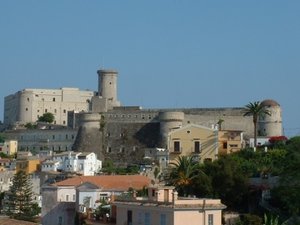Gaeta
|
|
Gaeta (ancient Caieta) is a seaport in the province of Latina in Lazio, Italy. It has a population of approximately 24,000.
History
During the break-up of the Roman empire, Gaeta, like Amalfi and Naples, would seem to have established itself as a practically independent port and to have carried on a thriving trade with the Levant. Its history, however, is obscure until, in 823, it appears as a lordship ruled by hereditary Itypati or consuls. In 844 the town fell into the hands of the Arabs, but four years later they were driven out with help supplied by Pope Leo IV. In 875 the town was in the hands of Pope John VIII, who gave it to the count of Capua as a fief of the Holy See, which had long claimed jurisdiction over it. In 877, however, the hypatus John (Joannes) II succeeded in recovering the lordship, which he established as a duchy under the suzerainty of the East Roman emperors. In the 11th century the duchy fell into the hands of the Norman counts of Aversa, afterwards princes of Capua, and in 1135 it was definitively annexed to his kingdom by Roger of Sicily. The town, however, had its own coinage as late as 1229.
In military history the town has played a conspicuous part. Its fortifications date back to Roman times, and a first-century mausoleum of the Roman general Lucius Munatius Plancus stands atop the Split Mountain. These fortifications were extended and strengthened in the 15th century, and indeed throughout the history of the Kingdom of Naples (later the Two Sicilies). On September 30, 1707 it was stormed, after a three months siege, by the Austrians under Daun; and on August 6, 1734 it was taken, after a siege of four months, by French, Spanish and Sardinian troops under the future King Charles of Naples. The fortifications were again strengthened; and in 1799 it was temporarily occupied by the French. On July 18, 1806 it was captured, after an heroic defence, by the French under Masséna; and on July 18, 1815 it capitulated, after a three months siege, to the Austrians. In November 1848 Pope Pius IX, after his flight in disguise from Rome, found a refuge at Gaeta, where he remained until September 4, 1849. Finally, in 1860, it was the scene of the last stand of Francis II of the Two Sicilies against the forces of United Italy. Shut up in the fortress with 12,000 men, after Garibaldi's occupation of Naples, the king, inspired by the heroic example of Queen Maria, offered a stubborn resistance, and it was not till February 13, 1861 that, the withdrawal of the French fleet having made bombardment from the sea possible, he was forced to capitulate. Today NATO maintains a base of operations at Gaeta.
GaetaSErasmoDaSFrancesco_Wiki.JPG
After the Risorgimento and until World War II, Gaeta grew in importance and wealth as a seaport. The nearby town of Elena, separated after the Risorgimento and named after the queen of Italy, was reunited to Gaeta following World War I. Mussolini transferred Gaeta from the southern region known today as Campania (to which it is historically and culturally attached) to the central region of Lazio. During World War II, the city retained its strategic importance for Mussolini and later for his Nazi allies. After the king dismissed Mussolini, the latter was initially taken via Gaeta to the island prison of Ponza (where Mussolini had previously locked up many of his political enemies). To keep the population ignorant of the massive convoy, a false air-raid siren sounded. (Mussolini would later be transferred to Gran Sasso, from where the Germans rescued him.)
After Italy surrendered to the Allies, however, the town's fortunes began to decline. Recognizing the city's strategic importance, and fearful of an Allied landing in the area, German troops occupied the city and expelled most of the population. The zone of exclusion began with a five-kilometer border from the historical city center; soon after, however, the population was expelled even beyond this point. The Gaetani were finally ordered to leave the area completely; those who could not were placed in a concentration camp, and a few were taken to Germany.
Following the Allied advance across the Garigliano and the Allied occupation of Rome, the Gaetani were allowed to return to their city and begin the process of rebuilding. In subsequent decades the city has boomed as a beach resort, and has seen some success at marketing its agricultural products, primarily its tomatoes and olives. Many of its families count seamen among their number. However, the decades since World War II have been as difficult for Gaeta as they have been for most of Italy's southern regions (the so-called Mezzogiorno). In particular, its importance as a seaport has nearly vanished, and ferries to Ponza and elsewhere now leave from the nearby town of Formia. All attempts to build a permanent industry as a source of employment and economic well-being for the town have failed. Notable losses included the Littorina rail line (now used as a parking lot and a marketplace), the refinery, and the once-thriving glass factory (which remains unused).
Culture
Gaetani speak a dialect of Italian that, while similar to the nearby Neapolitan, is one of the few Italian dialects to preserve Latin's neuter gender. Distinctive local cuisine includes the tiella, which resembles both a pizza and a calzone. The town is also notable for its splendid beaches (Serapo, Fontania, Sant' Agostino), and its distinctive brand of olives, marketed throughout the world.
Gaeta has erected a monument to Giovanni Caboto (John Cabot), who according to many sources was born there (although other sources give Genoa).
External links
- gaeta.it (http://www.gaeta.it)
de:Gaeta

